unit 4: waves
1/47
Earn XP
Description and Tags
Name | Mastery | Learn | Test | Matching | Spaced |
|---|
No study sessions yet.
48 Terms
oscillations
any vibration that goes back and forth without an overall resultant displacement
describing oscillations — displacement (x)
the distance the particle has moved from its rest position (equilibrium)
describing oscillations — amplitude (A)
the maximum distance that a particle moves from its rest position (this is a scalar!)
describing oscillations — frequency (f)
he number of oscillations per second or the number of waves to pass a point every second (also a scalar because of time), f=1/T
describing oscillations — period (T)
the time it takes for an oscillating particle to complete an oscillation or the time for a wave to move through one complete wavelength
graphing oscillations
on a sine wave, movement would continue infinitely without friction
sine waves come from circular motion looking at vertical or horizontal displacement from a point on the circumference of the circle
time on the x axis, displacement on the y axis
the length between repeating parts of the sine wave is the time period, direction matters in this eg. from halfway going up the time period would need to be measured until it hits the line going up again (not the first point where it would be going in the other direction)
amplitude on the wave is symmetrical on the horizontal access and the space between the extremes and the x axis
relating displacement, velocity and acceleration in SHM
velocity is the derivative of displacement
acceleration is the derivative of velocity, the derivative of the derivative of displacement
displacement cannot be represented as a derivative but it is the anti derivative of velocity (the integral)
displacement lags T/4 behind velocity, 3T/4 ahead (out of phase by…)
velocity lags T/4 behind acceleration, 3T/4 ahead
displacement lags T/2 behind acceleration (can go either way as it is in the middle)
conditions for SHM
There is a fixed cyclical path.
There is a central equilibrium point.
The motion repeats at equal time periods (periodic).
Displacement, velocity, and acceleration change continuously.
There is a restoring force directed toward the equilibrium point.
definition of SHM
motion arising from acceleration of an object that is proportional to its displacement from a fixed equilibrium point (rest position) and directed toward that point.
motion arising from a linear restoring force directed to a fixed equilibrium point
what does a phase shift do?
Two sinusoidal curves of equal period have a phase shift that translates one curve relative to the other in time, expressed as a fraction of a cycle, or as an angle in radians or degrees
travelling wave
a disturbance that propagates (transmits) energy without transferring physical material (a medium)
mechanical wave
A mechanical wave propagates its disturbance through a medium by an oscillating movement of the particles in the medium
transverse wave
particles of the medium oscillate perpendicular to the direction of the wave and propagation of energy.
longitudinal wave
the particles of the medium oscillate parallel to the direction of the wave, the wave and oscillations follow the same direction
electromagnetic wave
propagates as a transverse wave through a medium or a vacuum by oscillations of coupled, time-varying electric and magnetic fields
how is wave length measured?
wavelength (λ) is measured in metres as is amplitude (A)
wavelength is peak to peak while amplitude is vertical from the x axis to the peak
definition of a ray
the line showing the direction in which a wave transfers energy
direction of propagation, the two are parallel
perpendicular to the wave front
definition of a wave front
the surface that travels with a wave and is perpendicular to the direction in which the wave travels (the ray)
the lines that are perpendicular to the ray
parallel to the direction of propagation
wave fronts and rays from a point sources
this diagram shows a point source so makes waves that propagate away from the point, making the wave fronts circles
the rays are parallel to the tangent of the circle — if you zoomed in enough the curve would look flat
the rays can be perpendicular to the wave front as the tangent will always be a straight line
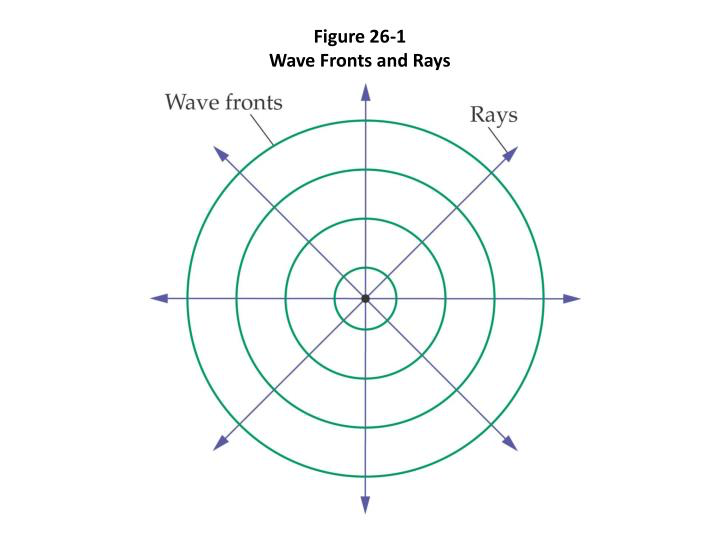
superposition
the resultant displacement at any point is the sum of the seperate displacements due to the two waves
the way we add waves, like dealing with vectors
constructive interference
constructive interference is when the waves are in phase so the amplitudes add together to produce a stronger signal
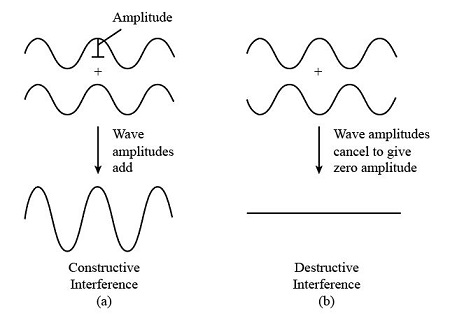
destructive interference
destructive interference is when the waves are out of phase so the amplitudes cancel each other out
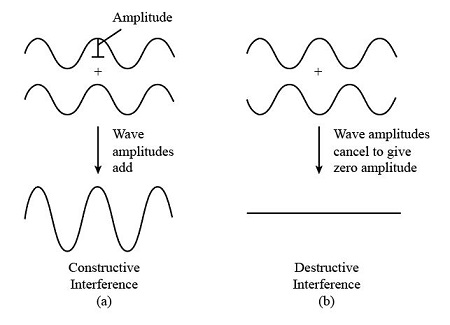
conditions for interference
only the amplitude can change if the waves have the same frequency, speed and wave length
the waves only cancel out completely is the amplitudes are the same
when two pulses meet they instantaneously become one and then continue as before having crossed over, this behaviour is different to particle collisions as the pulses do not join or rebound
intensity
intensity — the rate of energy transmitted (power) per unit area at right angles to the wave velocity
is proportional to the amplitude squared so doubling the amplitude will quadruple the intensity
measured in watts per square metre (Wm^-2)
energy is also proportional to the amplitude squared
polarisation of light
a polarised lens contains many long chains of molecules
after going through a polariser the amplitude of oscillations is diminished
critical angle
the smallest angle at which there is total internal reflection, the refractive angle is 90º
optical density
high to low optical density = away from the normal
low to high optical density = towards the normal
optical density has nothing to do with actual density, instead it is related to the refractive index
the refractive index of water is about 1.33
hot air and cold air have different refractive indexes
sine of a critical engle
the sine of the critical angle is n2/n1 so long as n2>n1 since the sine of any angle must be between -1 and 1
condition for total internal reflection
if the incident angle is greater than the critical angle there is total internal reflection such that the light goes like a mirror on the normal
how pulses collide
principle of superposition applies
when they overlap they add together
once they pass through each other they continue as if nothing happened
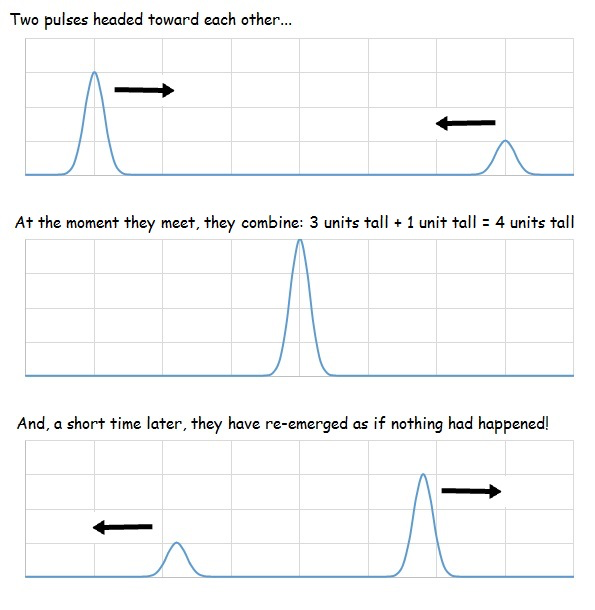
wave interference
waves of different frequencies can be added
any waves that are the same type (eg. both sound) can be added
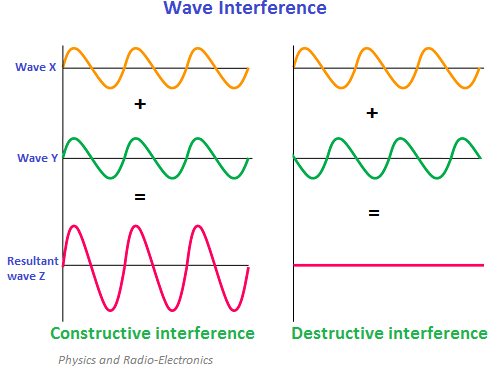
phase of waves
sine waves can be shown using a reference circle so can be referred to as an angle, this is the phase
completely out of phase (anti-phase)
the phase difference between the crests and valleys is pi which is referred to as completely out of phase
if waves that are completely out of phase meet the resultant displacement is zero
on a circle this is two points that are opposite each other showing the diameter of the circle
a phase difference of pi is also the distance of wave length/2
path difference
a whole number path difference results in a phase difference of 0º so constructive interference occurs
if the path difference is half a wave length away from being a whole number (eg. 121/2(λ)) the phase difference is pi so destructive interference occurs
coherent waves
coherent waves have a constant phase difference which can be anything so long as its constant
coherent waves also have the same frequency however not all waves with the same frequency will be coherent
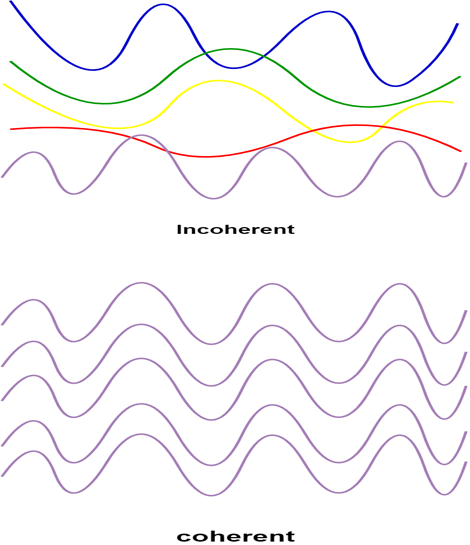
interference with coherent waves
two coherent sources of light will produce interference
when the path difference is an integer number of wave lengths (whole number) the interference will be constructive
destructive interference of coherent waves
a path difference of half a wave length will create maximum destructive interference
Huygen’s principle
Huygen’s principle — every point in a wave front is a point source of the wave
point source — a place in space which is an origin of waves
wave length definition
the distance between the wavefronts is the wavelength
the wavefronts are put at the peaks of the wave
the troughs are half way between the wavefronts assuming the waves are in SHM (are sinusoidal)
what is the energy in a wave proportional to?
the energy in a wave is proportional to the square of the wave’s amplitude
is the rate of energy transfer by waves constant?
straight waves in a uniform medium do not change wavelength or speed or direction or shape so the rate of energy transfer is also constant
for circular waves the amount of energy is constant along the wavefronts however it is distributed evenly so for the circumference of the wave front there is less energy the further from the point source it is measured, this is why amplitude decreases with distance for a circular wave
which waves can be polarised?
transverse waves
how is light polarised?
by going through a polariser
with an analyser perpendicular to the polariser no light is observed at the end
light must pass through thin molecular chains
reflecting light from a smooth surface
all light reflected from a smooth non-metallic surface is partially polarised
at a particular angle of incident (Brewster’s angle) on smooth insulators the light will be fully polarised
this is how polarising sunglasses work
Malus’ law
he relationship between intensity and the incident angle is not linear — the intensity of the unpolarised light entering the polariser must be twice the intensity of the polarised light leaving the polariser
small angle approximation (in radians!)
sinθ=0
cosθ=1
tanθ=0
standing wave definition
A standing wave (or stationary wave) is a wave in a medium in which each point on the wave axis has an associated constant amplitude – all points move coherently – and there is no transport of energy.
nodes on standing waves
The locations of zero amplitude are called nodes, and the locations of maximum amplitude are called anti-nodes. Adjacent nodes are separated by λ/2, where λ is the wavelength.
resonance
the situation in which an external driver oscillating at a system's natural frequency transfers energy into the system, which in this case is the standing wave.